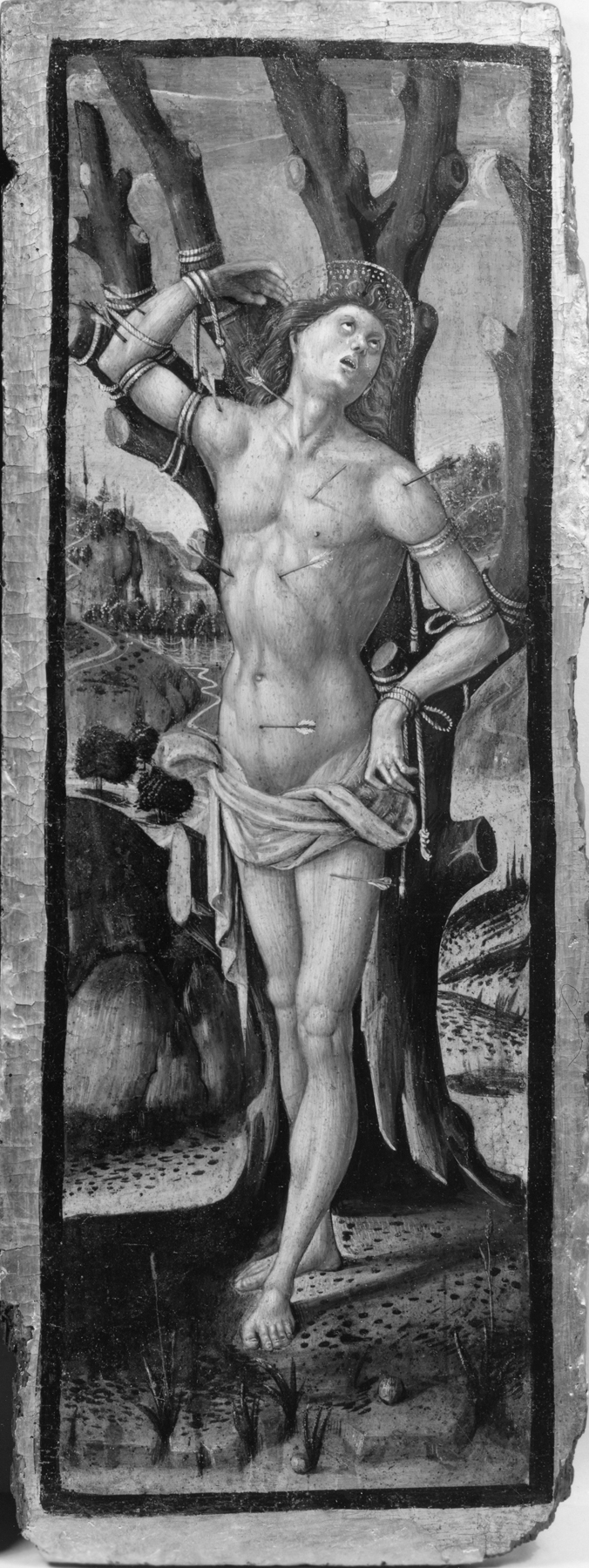St. Sebastian
(Renaissance Europe )
Together with a panel depicting Saint Anthony Abbot (37.689), this painting of Saint Sebastian bound to a tree and pierced by arrows was originally the wing of a triptych. According to legend Sebastian was a Roman commander under Emperor Diocletian (284-305 CE). After refusing to renounce his Christian faith, Sebastian's fellow soldiers shot him with arrows and left him for dead, but a woman named Irene later discovered his body and miraculously nursed him back to health. Sebastian was eventually arrested again and clubbed to death. Since he (initially) survived an experience that should have been fatal, he was popular in the Renaissance as a protector against disease, especially plague. In depicting his body as beautiful and idealized—unblemished by his wounds—the artist is alluding to Sebastian’s effectiveness as a divine protector.
Very little is known about the artist, Monaldo, sometimes called “Truffetta,” meaning trickster." He appears to have been active primarily in his native city of Viterbo (between Siena and Rome). The Walters’ panels are particularly close to his signed altarpiece of the “Lamentation Over the Dead Christ,” dated 1507, in the Palazzo Vitellschi in the nearby town of Tarquinia.
Provenance
Provenance (from the French provenir, 'to come from/forth') is the chronology of the ownership, custody, or location of a historical object. Learn more about provenance at the Walters.
Don Marcello Massarenti Collection, Rome [date and mode of acquisition unknown] [1897 catalogue: no. 329, as Pinturicchio]; Henry Walters, Baltimore, 1902, by purchase; Walters Art Museum, 1931, by bequest.
Conservation
| Date | Description | Narrative |
|---|---|---|
| Examination | examined for condition | |
| Technical Report | examined for technical study | |
| 6/22/1957 | Treatment | cleaned; other |
| 1/2/1958 | Treatment | cleaned; loss compensation; coated; other |
Geographies
Italy, Lazio, Viterbo
(Place of Origin)
Italy, Viterbo (Place of Origin)
Measurements
Painted surface H including painted black border: 24 5/16 x W: 8 3/16 in. (61.7 x 20.8 cm); Panel H: 25 7/8 x W: 9 3/4 x D: 3/4 in. (65.8 x 24.7 x 1.9 cm)
Credit Line
Acquired by Henry Walters with the Massarenti Collection, 1902
Location in Museum
Not on view
Accession Number
In libraries, galleries, museums, and archives, an accession number is a unique identifier assigned to each object in the collection.
In libraries, galleries, museums, and archives, an accession number is a unique identifier assigned to each object in the collection.
37.689


